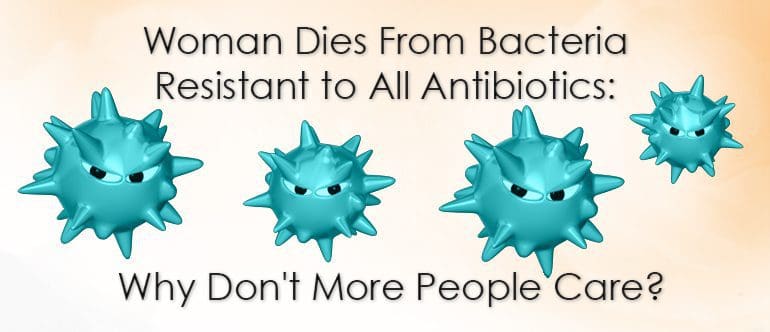Call us toll-free: 800-878-7828 — Monday - Friday — 8AM - 5PM EST

By Bruce Y. Lee for Forbes
Welcome to the future…a bad future. In September 2016, a female in her 70s died from an infection caused by carbapenem-resistant Enterobacteriaceae (CRE), bacteria that was resistant to all available antibiotics. Yes, resistant to all available antibiotics. Yes, doctors could do nothing to stop her infection. Yes, a bad infection from such bacteria can kill you no matter how rich or famous you are, what apps you have on your phone or social media sites you frequent, what kind of walls you build, how many nuclear weapons you have or how many other medications, procedures, herbs, supplements, chiropractic adjustments, face lifts, cupping sessions, urine drinks, leech treatments, cryotherapy sessions or massages you get. This is the first appearance in the U.S. of such an uber-resistant bacteria (meaning resistant to all antibiotics and not to drivers and cars for hire.) Yes, more and more will appear in the future. No, this is not trending on Twitter or Facebook. No, this is not getting nearly as much attention as the seemingly science-resistant anti-vaccine talk. Why, then, aren’t more people taking this seriously and making the urgent changes needed?
Nevada health officials Lei Chen, Ph.D., Randall Todd, Dr.P.H., and Julia Kiehlbauch, Ph.D., and Centers for Disease Control and Prevention (CDC) officials Maroya Walters, Ph.D., and Alexander Kallen, M.D., described the case and events in a recent issue of the Morbidity and Mortality Weekly Report (MMWR). The woman had broken her right leg during a trip to India, struggled with repeated right hip infections while there and then, after her return to the U.S., was admitted to a hospital in the Reno, Nevada, area on August 18 when her infection had progressed to affect her entire body. The CRE found to be causing in the infection was resistant to 26 antibiotics, including all aminoglycosides and polymyxins tested. With no effective antibiotics available, she eventually went into septic shock and died.
Consider this latest case yet another warning to society. Scientists and public health officials have been trying to get the attention of policy makers, investors, pharmaceutical companies and the public. Many public health officials, including CDC Director Tom Frieden, have called CRE the “phantom menace.” Our RHEA computational modeling work published in the American Journal of Epidemiology has shown how CRE will continue to spread more and more throughout hospitals and nursing homes, unless something changes.
Once again, we are losing the war against bacteria. New antibiotic development is just not keeping pace with the emergence of new antibiotic-resistant bacterial strains. As I mentioned previously when a colistin-resistant bacterial strain appeared in Pennsylvania last year, a Pew Charitable Trust report found that too few antibiotics are under development, and a majority of antibiotics are being developed by small companies, not big pharmaceutical companies. Many big pharmaceutical companies are just not stepping up to the challenge. Many doctors, dentists, farmers and animal caretakers continue to overuse antibiotics, leading to more and more antibiotic-resistant bacteria. Infections are very, very, very common. You will in all likelihood get an infection that requires antibiotics at some point in your life. What if the next time you get an infection, nothing works against it…and thus you’re out of luck?
Why isn’t there more urgency and action? Where was the mention about the lack of antibiotic development during the Presidential election? Where are the tweets? We hear about the possibility of a vaccine and autism panel led by Robert Kennedy, Jr., who as Seth Mnookin describes in Scientific American, has promoted anti-vaccine propaganda for more than a decade, when there is no scientific evidence linking vaccines to autism. Yet, there’s no talk among the incoming administration about forming a similar panel to address antibiotic-resistant bacteria and the lack of antibiotic development. Will a vaccine and autism panel waste taxpayers’ money and time while antibiotic-resistant bacteria continue to spread and gain strength?
Taking on vaccines in an unscientific manner when antibiotic-resistant bacteria is spreading would be like fighting against your coaching staff and cheerleaders when you really should be worrying about your opponent on the football field. Remember the first three Star Wars prequels, Episodes I though III (I know, you may not want to remember them), which started with the Phantom Menace, when everyone fought the wrong opponents while the Emperor and the Dark Side quietly took control? Well, folks, that’s what may be happening now.
